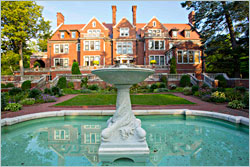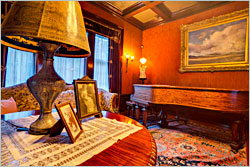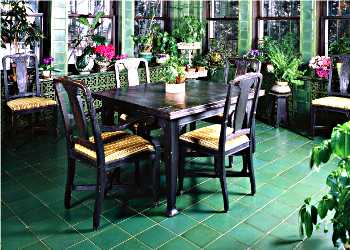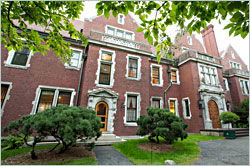Duluth's grand mansion
At Glensheen, tourists walk into the life of an extraordinary family.

© Glensheen
It took a servant a day and a half to polish one of their chandeliers. It took three Norwegian craftsmen three years to carve their woodwork.
Still, it's hard to begrudge Chester and Clara Congdon their nice things, because apparently they were very nice people.
Chester gave 11 miles of Lake Superior shoreline to the people of Duluth and made sure it was preserved for them in perpetuity.
Clara donated her time and resources to the Methodist church; her servants ate the same meals she did and were paid twice as much as other servants.
The couple slept together in a small bed, took their six kids and nephew on vacations to historic sites and expositions and welcomed a constant stream of friends and relatives to the home they called Glensheen.
"The Congdons were very hospitable, they were very nice people," guide Myrna Breivik said emphatically, when I toured the home. "They might have been rich, but they were very nice."
Their 1908 home is a monument to opulence, built at a time when wealth was plowed into property, not stocks. But the couple was unusually down to earth, for tycoons. Their fathers were Methodist pastors of modest means, and the young people used church scholarships to attend Syracuse University in New York.
They graduated in 1875 and planned to marry, but five years later, after stints teaching in Chippewa Falls, Wis., and practicing law in St. Paul, Chester still couldn't afford it: In an 1880 letter to Clara, he listed his net worth as $9.67 in cash.
Within a year, however, his fortunes changed. He was taken under the wing of Minnesota's U.S. attorney, whom he later followed to Duluth.
After a chance meeting with Henry Oliver, he served as legal counsel for the Oliver Iron Mining Co. until U.S. Steel bought it in 1901. That year, at age 48, Congdon began his own mining company.
And the riches rolled in. By the time he was building Glensheen five years later, he was the second-richest man in Minnesota, after St. Paul railroad baron James J. Hill.
He had an uncanny ability to spot opportunity, making lucrative investments not only in Duluth's timber, ore and shipping industries but also in Washington state apple orchards and Arizona copper mines.
Clara Congdon, who taught while waiting for Chester to make good, had earned her degree in art and architecture.

© Glensheen
"Who could imagine such an opportunity as Glensheen, to put my education to use creating a beautiful and gracious home?" she wrote in her journal.
Today, their home is owned by the University of Minnesota.
Tourists troop through on tours, gawking at the Quezal glass sconces and chandeliers, the flamed-mahogany woodwork and Circassian-walnut furniture, the silk-covered walls and 22-carat gold-leaf ceiling.
"The 'Antiques Roadshow' would go crazy in here," Breivik said.
The Congdons, however, weren't ostentatious. Many of the objets d'art are souvenirs, collected on their travels around the world, and many of the paintings Clara did herself. None of the rooms is particularly large.
The most fabulous room is the smallest: the Arts and Crafts breakfast room, lined with windows, ferns and glowing green faience ceramic tiles.
When I visited Glensheen with friends one November, after the rooms had been lavishly decorated for the holidays, we started in the children's playroom, where our guide, opened a built-in bench filled with a jumble of puzzles and games.
"Imagine, they're from 1908 or 1910, and they're still here," Breivik said. "When the children married, they bought their own mansions, and they bought their own stuff, I imagine."
She looked at us more closely and smiled. "There are more than 300 Congdon descendants, so if you're one, let me know, so I can get an invitation to see one of those houses."
Our small group was on a Saturday Bedroom Slippers Tour, which meant we could waltz behind the velvet ropes in little blue booties, inspecting powder rooms and closets and even drawers.
In the living room, we stuck our noses as close as we could get to a Japanese "painting" of a waterfall that actually was embroidered in strands of silk thinner than a human hair and took 18 months to complete.
We looked for each room's symbolic motif — lions, water lilies, pomegranates — and in the daughter's bedrooms, we walked up to the windows to see who had gotten the best views.

© Beth Gauper
Elisabeth's room was smallest; she was the youngest daughter and never married, caring for her mother until Clara died in 1950 at age 96.
Elisabeth, who was active in many charitable causes and founded what became Duluth's Junior League, was still living in Glensheen when she was murdered there in 1977, along with her elderly nurse.
The case was sensational, and eventually, the alcoholic husband of Elisabeth's adopted daughter, Marjorie, confessed. Marjorie was charged with murder but was found not guilty.
Since then, she has been in and out of the news, charged with bigamy and the murder of her third husband (but not prosecuted) and convicted of arson in Minnesota and attempted arson in Arizona.
In Arizona, she was sentenced to serve 15 years, and a request for early parole was denied after being contested by at least 10 relatives. She was released but later pleaded guilty to attempted forgery.
It's a sad and tawdry addendum to Condon history — but one whose details fascinate the more than 100,000 people who go through the house every year. That's a silver lining for a public institution that has to pay a million for a new roof.
But Clara Congdon, a principled woman who didn't even want hops grown on the family's Washington ranch, would have been mortified by the specter of notoriety that hangs over her lovely house, and the nearly 40 Congdons who still live around Duluth aren't happy about it, either.

© Glensheen
For Elisabeth, vast riches were a gift that, in the end, turned on her. But for the rest of Minnesota, Chester and Clara Congdon's legacy simply is a gift.
Trip Tips: Glensheen Mansion in Duluth
Getting there: It's on Duluth's London Road, east of downtown.
Tours: Guided and self-guided tours are offered daily. Check for current hours.
The guided classic tour is $30, $18 for children 6-17, and the full-mansion guided tour, which includes the third floor and the attic, is $42 and $30. It's worth the extra money to hear the stories about the Congdons.
The standard self-guided one-hour tour is $20, $7 for children 6-17 and the 1½-hour full-mansion tour is $30 and $19.
The 90-minute, guided Lock & Key tour of hidden spaces in the house and grounds is $36, $24 for children 6-17.
Events: The estate offers many special events, including the popular Concerts on the Pier, Wednesday evenings in July and August. At Christmas, the mansion is decorated.
Follow Glensheen on Facebook for the most current events.
Information: Glensheen, 888-454-4536.
For help planning a trip, see Duluth 101.